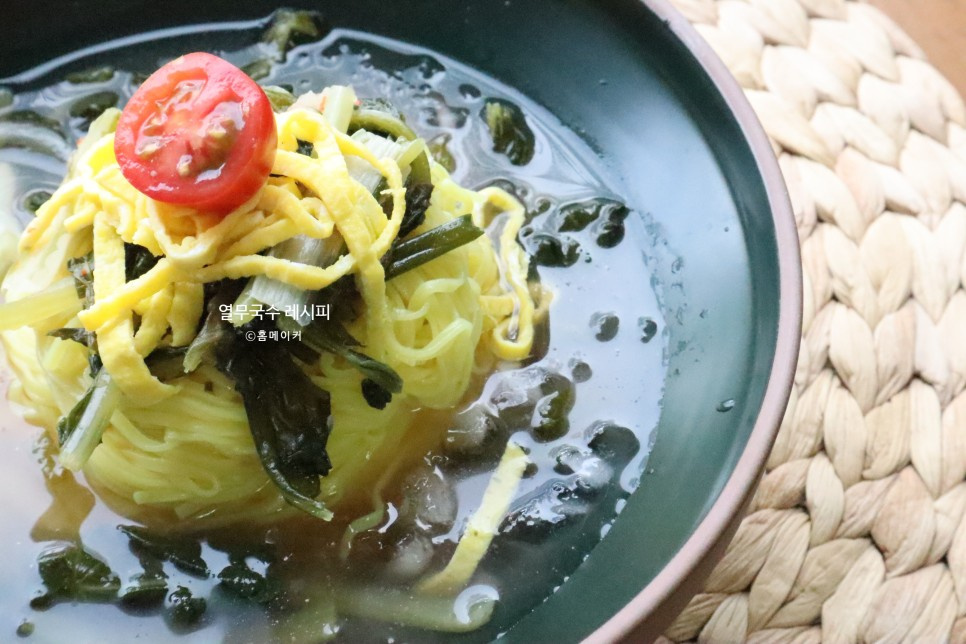Refreshing and Tangy Yeolmu Guksu (Young Radish Noodle Soup)
Easy Homemade Yeolmu Guksu Recipe: Including How to Cook Noodles

Introducing a refreshingly tangy Yeolmu Guksu, perfect for those warm, humid days! This dish is incredibly simple to make, requiring only well-fermented young radish kimchi. It’s a recipe so easy, anyone can master it, offering a cooling sensation akin to dipping your feet in a cool mountain stream.
Main Ingredients- Well-fermented Yeolmu Kimchi 469g (ensure you have about 300ml of kimchi brine)
- Chilled anchovy broth 200ml
- Noodles for soup (such as somyeon or hand-pulled noodles) 200g (approx. 100g per serving)
- 1 Egg (for a vibrant golden omelet garnish)
Refreshing Broth Seasoning- 2 Tbsp Vinegar (for a tangy flavor)
- 1 Tbsp Sugar (for a hint of sweetness)
- 1/8 tsp Salt (optional, adjust based on kimchi’s saltiness)
- 2 Tbsp Vinegar (for a tangy flavor)
- 1 Tbsp Sugar (for a hint of sweetness)
- 1/8 tsp Salt (optional, adjust based on kimchi’s saltiness)
Cooking Instructions
Step 1
First, prepare the star ingredient for your delicious Yeolmu Guksu: the Yeolmu Kimchi. Using kimchi that is well-fermented but not overly sour or spicy will result in the best broth flavor.

Step 2
To create a deep and refreshing broth, combine 300ml of the prepared Yeolmu Kimchi brine with 200ml of chilled anchovy broth. If you don’t have anchovy broth, kelp broth is also a great alternative.

Step 3
To the mixed broth, add 2 Tbsp of vinegar for tanginess, 1 Tbsp of sugar for a subtle sweetness, and 1/8 tsp of salt to balance the flavors. Stir well until the sugar and salt are completely dissolved. Taste and adjust the vinegar or sugar according to your preference. Chill the prepared broth thoroughly in the refrigerator; cold broth is essential for the best taste!

Step 4
Prepare the egg garnish. Crack 1 egg into a bowl, add a tiny splash of cooking wine or water to reduce any eggy smell and create a smoother omelet. Whisk the egg well, then pour a thin layer onto a heated, lightly oiled pan. Cook until golden brown on both sides. Once cooled, thinly slice it into strips.

Step 5
Now it’s time to cook the noodles. Bring a large pot of water to a rolling boil. Once boiling, carefully add the noodles (200g, approximately 100g per serving), spreading them out so they don’t clump together. Using plenty of water is key – about 1 liter of water for every 100g of noodles – to prevent sticking and ensure they cook up perfectly bouncy.

Step 6
When the water with the noodles starts to boil vigorously again, add half a cup of cold water to lower the temperature. This step helps to make the noodles chewier. Once the water returns to a boil, add the remaining half cup of cold water. This process removes excess starch, resulting in a cleaner noodle taste.

Step 7
While the noodles are cooking, gently stir them with chopsticks to prevent them from sticking to the bottom of the pot or clumping together. The cooking time will vary depending on the thickness of the noodles, but typically 4 to 5 minutes is sufficient. To check for doneness, you can taste a strand or rinse one under cold water to see if the center is tender without any starchy core.

Step 8
Once the noodles are cooked, immediately drain them in a colander. Then, rinse them thoroughly under cold running water several times. This rinsing process removes any residual starch, making the noodles perfectly firm and clean tasting.

Step 9
After rinsing and draining, place the noodles into individual serving bowls. Twirling the noodles as you place them in the bowl can make for a more visually appealing presentation.

Step 10
Generously ladle the chilled, tangy broth over the noodles. Top with a portion of the crisp Yeolmu Kimchi and the prepared egg omelet strips. Your beautiful bowl of Yeolmu Guksu is now complete! Enjoy your delicious meal.^^




